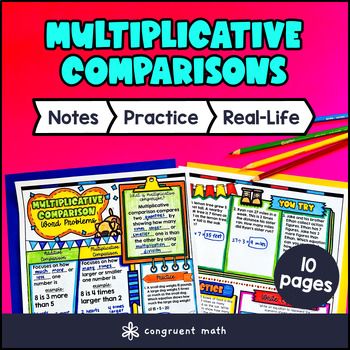Want more ideas and freebies?
Get my free resource library with digital & print activities—plus tips over email.
Join for Free Resources →
$4.25
Ever wondered how to teach multiplication as multiplicative comparison in an engaging way to your 4th grade students?
In this lesson plan, students will learn how to distinguish multiplicative comparison from additive comparison and apply these concepts to solve word problems. Through artistic, interactive guided notes, checks for understanding, a color-by-code activity, and a maze worksheet, students will build a strong comprehension of multiplication comparisons.
The lesson culminates with a real-life example that explores how multiplying quantities helps in everyday decision-making and problem solving.

$4.25
After this lesson, students will be able to:
Before this lesson, students should be familiar with:
As a hook, ask students if they have ever compared the size or amount of something to another, such as comparing how many apples one person has versus another. How do they figure out which is more, and by how much? Refer to the last page of the guided notes as well as the FAQs below for ideas to engage students in real-life multiplication comparisons.
Use the first page of the guided notes to introduce the concept of multiplicative comparison versus additive comparison. Walk through how multiplicative comparison means “times as many” rather than just “more than,” emphasizing the difference between adding and multiplying to compare quantities. Check that students understand that multiplicative comparison answers questions like “How many times as much?” instead of “How many more?” Refer to the FAQ below for a detailed walkthrough and strategies to clarify common misconceptions, such as confusing multiplicative comparison with addition or subtraction.
Use the second page of the guided notes to introduce models and equations that represent multiplicative comparison word problems. Guide students in identifying key words and phrases that signal multiplicative comparison (e.g., “times as many,” “twice as many”), then show how to translate these into multiplication or division equations. Highlight how to use bar models or tape diagrams as visual tools to solve these problems. Refer to the FAQ below for step-by-step strategies and ideas for scaffolding this process.
Based on student responses during the checks for understanding embedded in the guided notes, reteach any concepts that need reinforcement—such as distinguishing between additive and multiplicative comparison or setting up correct equations. If your class has a wide range of proficiency levels, consider pulling out students who need extra help for targeted reteaching sessions, while encouraging more advanced students to begin the practice exercises to deepen their understanding.
Have students practice multiplication as multiplicative comparison using the color by code worksheet activity. Walk around to answer student questions.
Fast finishers can dive into the maze activity for extra practice. You can assign it as homework for the remainder of the class.
Bring the class back together, and introduce the concept of using multiplicative comparisons to solve real-world problems, such as figuring out how many times more one quantity is than another in everyday situations like comparing the number of apples in two baskets or the distance between two cities. Emphasize how multiplication helps us understand these comparisons quickly and accurately. Refer to the FAQ for more ideas on how to teach it!
If you’re looking for digital practice for multiplication as multiplicative comparison, try my Pixel Art activities in Google Sheets. Every answer is automatically checked, and correct answers unlock parts of a mystery picture. It’s incredibly fun, and a powerful tool for differentiation.
Here’s 1 activity to explore:
Multiplication as multiplicative comparison means comparing quantities by how many times one number is larger or smaller than another using multiplication rather than addition.
You can identify a multiplicative comparison word problem if it asks how many times greater, faster, or more one quantity is compared to another. Look for keywords like times as much, twice as many, or three times greater.
The difference lies in how quantities are compared:
You can use visual models like tape diagrams or bar models to represent the relationship between quantities.
Key words that indicate multiplication comparisons include:
To write an equation:
Yes, division can be used to find the missing quantity in a multiplicative comparison.
Learning multiplicative comparison helps build foundational skills in understanding ratios and proportional relationships, which are critical for higher-level math concepts.
Get my free resource library with digital & print activities—plus tips over email.
Join for Free Resources →